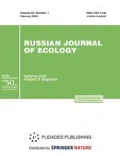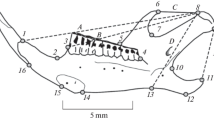Abstract
Methods of geometric morphometrics have been used to estimate the influence ratio of nonselective elimination and drought factors on variation in the shape and size of the mandible in the population of bank vole (Clethrionomys glareolus Schreb.) in the southern taiga subzone. Nonselective elimination of rodent populations for medical and sanitary purposes was carried out in a felling site located in a focus of hemorrhagic fever, in the spring of a climatically normal year and of a dry year. The summer samples of mature young of the year from control bank vole colonies and impact colonies (i.e., recovered after deratization) in adjacent years have been compared. The results show that drought, nonselective elimination, and the interaction of these factors have significant effects on the size and shape of the mandible. Changes in its shape under drought conditions are largely due to allometry. Morphogenetic effects of nonselective elimination are highly repeatable between climatically different years. A significantly higher level of within-group morphological disparity (MNND) of the undisturbed control cenopopulation in a dry year has been revealed, which indirectly indicates a stronger destabilization of morphogenesis upon exposure to the autecological factor. Every ecological factor contributes to the development of specific configurations of the mandible; i.e., it induces certain changes in morphogenesis in response to aut- and synecological effects and their combination.
Similar content being viewed by others
References
Mayr, E., Animal Species and Evolution, Cambridge: Harvard Univ. Press, 1963. Translated under the title Zoologicheskii vid i evolyutsiya, Moscow: Mir, 1968.
Shvarts, S.S., Evolyutsionnaya ekologiya zhivotnykh: Ekologicheskie mekhanizmy evolyutsionnogo protsessa (Evolutionary Ecology of Animals: Ecological Mechanisms of the Evolutionary Process), Sverdlovsk: Ural. Fil. Akad. Nauk SSSR, 1969.
Nei, M., Maruyama, T., and Chakraborty, R., The bottleneck effect and variability in populations, Evolution, 1975, vol. 29, pp. 1–10.
Shvarts, S.S., Ekologicheskie zakonomernosti evolyutsii (Ecological Patterns of Evolution), Moscow: Nauka, 1980.
Vasil’ev, A.G., Epigeneticheskie osnovy fenetiki: na puti k populyatsionnoi meronomii (Epigenetic Bases of Phenetics: On the Way to Population Meronomy), Yekaterinburg: Akademkniga, 2005.
Vasil’ev, A.G., Bol’shakov, V.N., Vasil’eva, I.A., et al., Assessment of nonselective elimination effects in rodent communities by methods of geometric morphometrics, Russ. J. Ecol., 2016, vol. 47, no. 4, pp. 383–391.
Semerikov, V.L., Semerikova, S.A., Polezhaeva, M.A., et al., Southern montane populations did not contribute to the recolonization of West Siberian Plain by Siberian larch (Larix sibirica): A range-wide analysis of cytoplasmic markers, Mol. Ecol., 2013, vol. 22, pp. 4958–4971.
Lee, Y.S., Markov, N., Voloshina, I., et al., Genetic diversity and genetic structure of the Siberian roe deer (Capreolus pygargus) populations from Asia, BMC Genet., 2015, vol. 16, no. 100, pp. 1–15.
Yablokov, A.V., Izmenchivost’ mlekopitayushchikh (Variation in Mammals), Moscow: Nauka, 1966.
Olenev, G.V., Population mechanisms of adaptation to extreme environmental factors: The example of bank vole, Zh. Obshch. Biol., 1981, no. 4, pp. 506–511.
Rohlf, F.J. and Slice, D., Extension of the Procrustes method for the optimal superimposition of landmarks, Syst. Zool., 1990, vol. 39, no. 1, pp. 40–59.
Zelditch, M.L., Swiderski, D.L., Sheets, H.D., and Fink, W.L., Geometric Morphometrics for Biologists: A Primer, New York: Elsevier, 2004.
Klingenberg, C.P., MorphoJ: An integrated software package for geometric morphometrics, Mol. Ecol. Resour., 2011, vol. 11, pp. 353–357.
Rohlf, F.J., TpsUtil, File Utility Program, Version 1.60, Stony Brook, NY: Department of Ecology and Evolution, State University of New York, 2013.
Rohlf, F.J., TpsDig, Digitize Landmarks and Outlines, Version 2.17, Stony Brook, NY: Department of Ecology and Evolution, State University of New York, 2013.
Rohlf, F.J., Shape statistics: Procrustes superimpositions and tangent spaces, J. Classification, 1999, vol. 16, pp. 197–223.
Vasil’ev, A.G., Vasil’eva, I.A., Gorodilova, Yu.V., and Dobrinskii., N.L, Chernov’s compensation principle and the effect of rodent community completeness on the variability of bank vole (Clethrionomys glareolus) population in the Middle Urals, Russ. J. Ecol., 2017, vol. 48, no. 2, pp. 161–169.
Mitteroecker, P., Gunz, P., Windhage, S., and Schaefer, K., A brief review of shape, form, and allometry in geometric morphometrics, with applications to human facial morphology, Hystrix, 2013, vol. 24, pp. 59–66.
Davis, J.C., Statistics and Data Analysis in Geology, New York: Wiley, 1986. Translated under the title Statisticheskii analiz dannykh v geologii, Moscow: Nedra, 1990, vol.2.
Hammer, O., New methods for the statistical analysis of point alignments, Comput. Geosci., 2009, vol. 35, pp. 659–666.
Donnelly, K.P., Simulations to determine the variance and edge effect of total nearest-neighbour distances, in Simulation Methods in Archaeology, Hodder, I., Ed., Cambridge: Cambridge Univ. Press, 1978, pp. 91–95.
Hammer, Ø., Harper, D.A.T., and Ryan, P.D., PAST: Paleontological statistics software package for education and data analysis, Palaeontol. Electron., 2001, vol. 4, no.1.
Vasil’ev, A.G., Bol’shakov, V.N., Vasil’eva, I.A., and Sineva, N.V., Aftereffects of muskrat introduction in Western Siberia: Morphological and functional aspects, Russ. J. Biol. Invasions, 2017, vol. 8, no. 1, pp. 1–9.
Evdokimov, N.G., Analysis of mechanisms of abundance recovery in an artificially depleted population of rodents in a forest biocenosis, in Populyatsionnaya ekologiya i izmenchivost’ zhivotnykh (Animal Population Ecology and Variation), Sverdlovsk: Ural. Nauch. Tsentr Akad. Nauk SSSR, 1979, pp. 84–95.
Author information
Authors and Affiliations
Corresponding author
Additional information
Original Russian Text © A.G. Vasil’ev, V.N. Bol’shakov, I.A. Vasil’eva, N.G. Evdokimov, N.V. Sineva, 2018, published in Ekologiya, 2018, No. 3, pp. 205–213.
Rights and permissions
About this article
Cite this article
Vasil’ev, A.G., Bol’shakov, V.N., Vasil’eva, I.A. et al. Morphogenetic Effects of Drought and Nonselective Elimination in Population of Bank Vole (Clethrionomys glareolus) in Southern Taiga Subzone. Russ J Ecol 49, 241–247 (2018). https://doi.org/10.1134/S1067413618030104
Received:
Published:
Issue Date:
DOI: https://doi.org/10.1134/S1067413618030104



